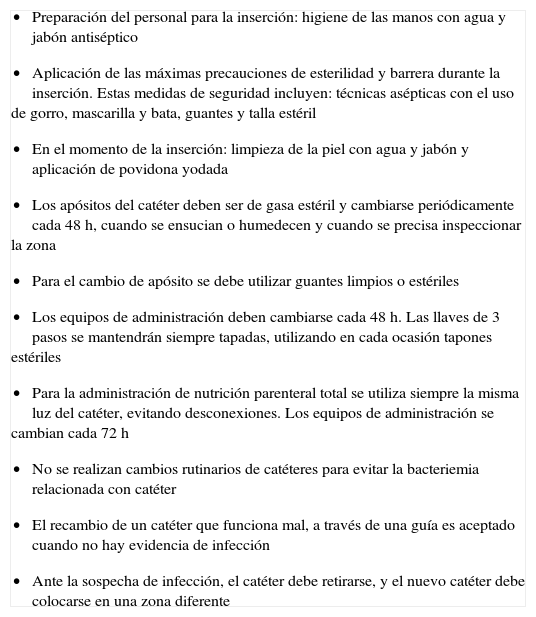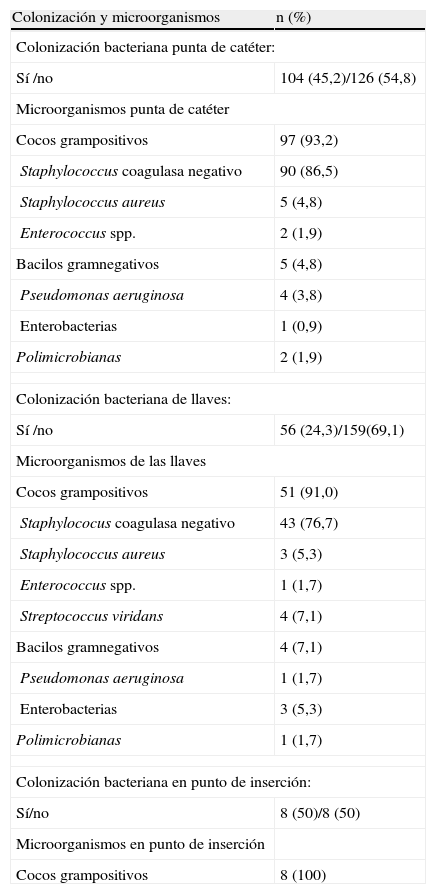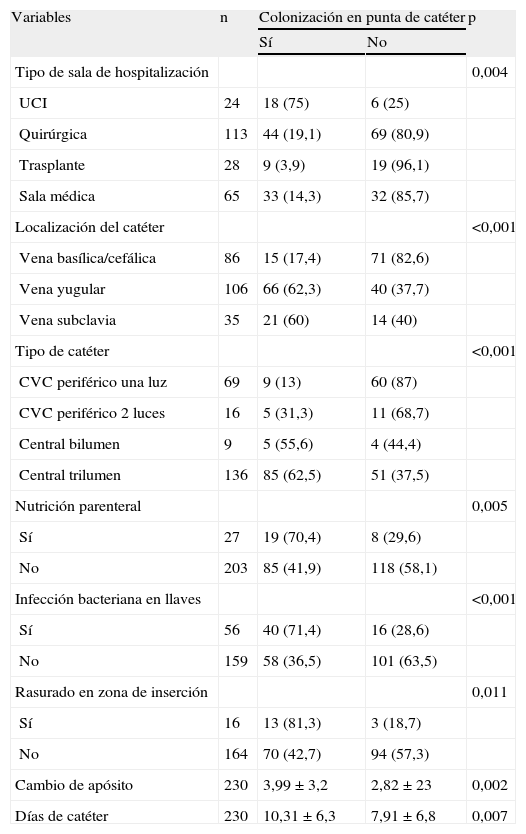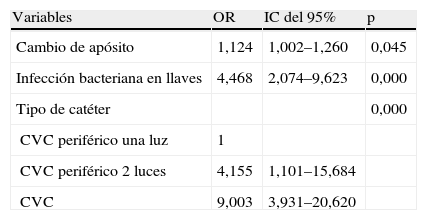Conocer la incidencia de colonización de los catéteres venosos centrales (CVC) en las unidades de hospitalización del Institut de Malalties Digestives i Metaboliques (IMDiM) del Hospital Clínic de Barcelona con intención de reducir el riesgo de infección.
MétodoEstudio descriptivo, prospectivo y longitudinal, de 4 meses de duración. Fueron objeto de estudio los pacientes ingresados en las unidades del IMDiM, portadores de CVC (n = 230). Al retirar el catéter, se procedía al cultivo de la punta del mismo, realizándose 2 hemocultivos si el paciente presentaba fiebre. Se creó una base de datos. Se analizó con SPSS versión 11.0. Las variables se compararon mediante prueba de χ2, test de la t de Student y se realizó un análisis multivariante mediante la regresión logística de Cox, considerándose significativa una p igual o inferior a 0,05.
ResultadosEl cultivo de punta de catéter fue positivo en el 45,2%, con una tasa de bacteriemia relacionada con catéter, clínicamente significativa de 2,9 ‰ días de catéter. La probabilidad de contaminación de punta de catéter fue del 25% a los 10 días de colocación. Realizado el análisis multivariado, observamos que el tipo de catéter, el cambio de apósito y la infección bacteriana de las llaves, fueron las 3 variables independientes asociadas a un mayor riesgo de infección.
ConclusionesEstos resultados sugieren que: 1) se debería revisar y actualizar el protocolo de inserción y mantenimiento de catéteres; 2) valorar la permanencia de éstos a partir del 10.º día, y 3) seleccionar adecuadamente el tipo de catéter que se va a colocar, utilizar el de menor número de luces necesario, así como disminuir el número de cambios de apósito.
To evaluate the incidence of central venous catheter (CVC) colonization in inpatient units of the Institut de Malalties Digestives i Metabòliques (IMDiM) of Hospital Clinic (Barcelona, Spain) with a view to reducing the risk of infection.
MethodA 4-month descriptive, prospective and longitudinal study was performed. A total of 230 patients admitted to the IMDiM with CVC were included during the study period. At catheter removal, the tip was cultured and, if the patient had fever, two blood cultures were also obtained. A database was created. Data were analyzed using SPSS v.11.0. Variables were compared with the Chi-square and Student's t-tests and a multivariate analysis was performed using Cox logistic regression. A value of P<0.05 was considered significant.
ResultsCatheter tip culture was positive in 45.2%. The rate of catheter-related bloodstream infections was 2.9 ‰ catheter-days, which was clinically significant. The probability of catheter tip contamination 10 days after placement was 25%. Multivariate analysis revealed that the independent variables associated with a higher risk of infection were catheter type, changes of dressing, and infected bacterial stopcocks.
ConclusionsThese results suggest that: 1) the protocol for catheter insertion and care should be reviewed and updated, 2) catheter removal should be considered after the 10th day, 3) the appropriate type of catheter should be selected, the catheter with the lowest number of lumens should be used, and changes of catheter dressing should be reduced.
Artículo
Comprando el artículo el PDF del mismo podrá ser descargado
Precio 19,34 €
Comprar ahora












